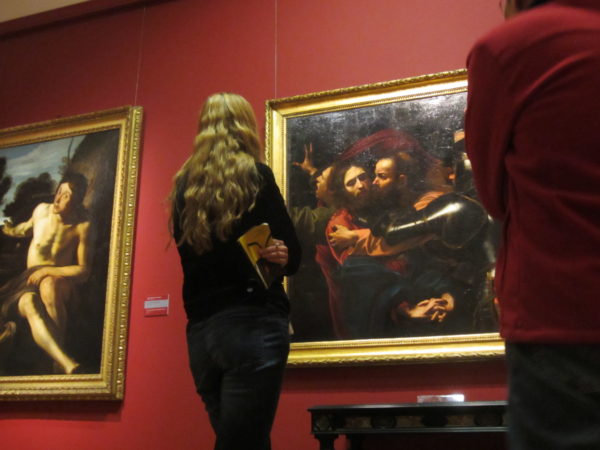
The circumstances of Caravaggio’s death in 1610 remain shrouded in mystery. After murdering a man in a street duel he had been a fugitive for several years, but by the time of his death he was returning to Rome to receive a papal pardon. At some point during this journey he died, possibly because of syphilis, probably because of an infected sword wound. The backgrounds of his work are equally enigmatic, which is emphasised by the rediscovery of one of his greatest paintings in a Jesuit dining room in 1993 – after being presumed lost for 200 years.
For the past 25 years “The Taking of Christ” has been hanging in the National Gallery. Since then, scholars have worked valiantly to trace the strange voyage of a Renaissance masterpiece from the palace of a prominent 17th-century Roman cardinal to its current residence on Nassau Street. The painting’s history borders on the absurd: aside from being donated to the Irish Jesuits in the 1930s, it had been re-attributed to a Dutch master and spent a century in an estate in the Scottish Highlands. Its recognition and re-attribution in 1993 was a work of monumental scholarship, and its first unveiling drew over 100,000 people to the National Gallery, decimating all previous attendance records.
On Thursday night, to commemorate the painting’s 25th year in Ireland, the National Gallery hosted a lecture on Caravaggio, delivered by Prof Richard Spear. Public lectures rarely exceed the capacity of an auditorium, but Caravaggio’s name reduced normally civilised museum goers to clamouring at the door for an opportunity to sit on the floor. Spear’s lecture concentrated on the economic actualities of the art world of 17th-century Rome. This was a world in which the sum of 125 scudi (around €450) – how much Caravaggio received for “The Taking of Christ” – was an unusually large amount to pay for such a painting. A family could live on 90 scudi a year, while it was not unheard of for a Cardinal to make 50,000 scudi a year. This pervasive economic inequality generated ample conditions for the patronage of some of the greatest artworks the world has ever known.
Alongside this, Spear spoke of what he named “the art historian’s disease”. When one studies the chaotic world of Renaissance Italy for any amount of time, one begins to obsess over coincidences and contradictions. The art historian is plagued by uncanny resemblances between frescoes, by unanswerable questions related to the artist’s own religious convictions, by the fact that Caravaggio paints the narrative of Judas’s betrayal of Jesus backwards, by how much it cost to buy a loaf of bread in 17th-century Rome. Meanwhile, the figure of Caravaggio, hoisting a lantern above the calamity of Jesus’s arrest, remains tantalisingly out of reach. Spear mused on similarities between Caravaggio’s aesthetics and contemporaneous Jesuit aesthetics – a coincidence that is vitalised by the painting’s bizarre second birth in a Jesuit home. Even more outlandish is the fact that Caravaggio’s patron at the time, Geronimo Mattei, was the papal “protector of Ireland”.
In 1962 Ellis Waterhouse remarked that “the innocent reader of art-historical literature could be forgiven for supposing that [Caravaggio’s] place in the history of civilization lies somewhere in importance between Aristotle and Lenin”. Indeed, the figure of Caravaggio as a cross between a vagabond and a theologian has captivated the 20th-century imagination in a way few painters have. It takes a true genius to draw praise from both Pope Benedict and The Rolling Stones. With “Caravaggiomania” showing no sign of waning, it is a daily gift to the Irish nation that such a masterpiece takes pride of place in the National Gallery and can command a commemoration by itself. For this we can only thank a 17th-century, heavily-bearded Italian murderous painter, and, of course, the Jesuits.






